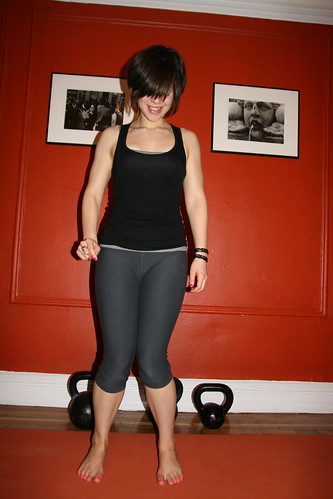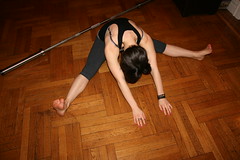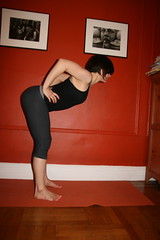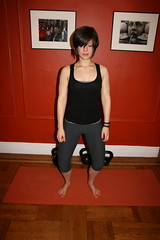Weak In The Knees
A common problem that needs to be addressed with athletes is what I call the “Weak Knee Syndrome.” You’ll encounter this movement error in the dip portion of the push press, the hang clean, the jerk, the box jump and even in squats and deadlifts. It mostly occurs in female clients due to the greater width of their hips but you will see it in men too.
Here is what it looks like:

The problem arises when an athlete tries to bend their knees and allows the knees to drop in medially in a knock-kneed-fashion such that the knees no longer track over the toes. To be clear I am discussing a faulty movement pattern not a structural abnormality. Some people are born with knock knees and that is not the same problem although athletes with knock knees are more prone to this error.
Because the movement is fundamental and embedded into so many exercises that we do at Crossfit it behooves you to correct the problem quickly and constantly police it in your clients. Failure to spot and correct this problem will lead to poor performance and to injury. Look at this article discussing how this problem leads to knee injuries for women in sports.
There are several theories as to what causes the knees to knock together, so there is not one quick fix for everyone. One theory is that because women’s hips are wider and often their hamstrings are weaker it leads to the instability of knee joint. The hips cannot be narrowed, but the hamstrings can be strengthened and the stance can be adjusted wider so that the feet are directly under the hips. Another theory is that pronated feet lead to instability of the knee. The feet can be strengthened over time and working out barefooted or in lifting shoes will help. Yet another theory is that there is an adductor/abductor imbalance that causes the knees to knock together. This is easily fixed over time with stretching exercises for the adductors and strengthening for the abductors. However the best way to strengthen the muscles involved is to teach your athlete to do the movement correctly and thus do the primary exercises better, i.e. hang cleans and push presses performed correctly will strengthen the muscles needed for those exercises as well as for other sports.
Your task is to assess the problem in yourself or your clients and try all of these things and see which are the best solutions for your particular case.
Let us look at the problem in greater detail from the ground up. For ease of discussion we are going to address this problem in the context of the dip portion of the push press, but it can show up anywhere, so be on the alert. Some people squat well but express the Weak Knee Syndrome in the hang clean or box jump and others express it in all knee flexion/extension exercises.
Watch the video to see how to fix this problem.
First, the feet. When I encounter an athlete with this Knock Knee Syndrome, I have them take off their shoes and socks and examine their feet. I look to see if they have fallen arches and if they pronate their feet. I want to see if I can get the clients to lift their arches. I ask them to keep their feet planted but to lift and spread their toes. Doing this usually improves contact with their heels onto the floor as well as the outer edges of their feet and lifts the arches. I try to have them do some squats while keeping their toes up. We see if that helps.


Turning the toes out an lifting and spreading the toes can help with pronation.
Second, the adductors. I check to see if they have really tight adductors that are pulling their knees in medially. The easiest way is to have them lie down and slide their legs up a wall and open into a straddle. I can simultaneously check their hamstring flexibility here. If the athlete appears to be tight I will keep them in this position for about 3 minutes and then resume working on dip/drive.


If you are really tight, then it will be easier to stay in the first stretch than the second one. Spend a lot of time there if you need it.
Third, the hamstrings and glutes. Weak hamstrings and glutes can lead to instability in the knees. I will have the athlete do some good morning to see if I can get them to engage their hamstrings.

Once the athlete can move the torso without losing the arch in their back, then I will add some weight for resistance.

This is what the dip should look like. The knees and toes point in the same direction and the athlete is maintaining good posture.
I work the dip over and over again with my clients trying to use as many of these fixes as is appropriate. Because the movement is prevalent in so many exercises I can make them practice dip/drives every session in some form. I prescribe my clients hamstring, glute and foot strengthening exercises and adductor stretches as necessary.
Was this article helpful? Please leave a comment.

They also say a contributing factor to knees knocking during some of these exercises is weak glute meds (medius), which are external rotators preventing the internal rotation movement at the hip keeping the knees from knocking.
Back Exercises…
[…]Weak In The Knees | CrossFit Virtuosity | New York City[…]…
If I was born with knock knees, will any excercise help? I have been doing some research and it show that seated addction and lateral lunges can be effective. I really need advice on how to correct my knock knees that i was born with. I had some hope to correct, until I read your article that stated “Some people are born with knock knees and that is not the same problem although athletes with knock knees are more prone to this error”. Please respond and desperate and almost suicidal!!!!
I am really inspired with your writing skills and also with the format on your blog. Is this a paid topic or did you customize it yourself? Either way stay up the nice quality writing, it is uncommon to see a great weblog like this one these days..